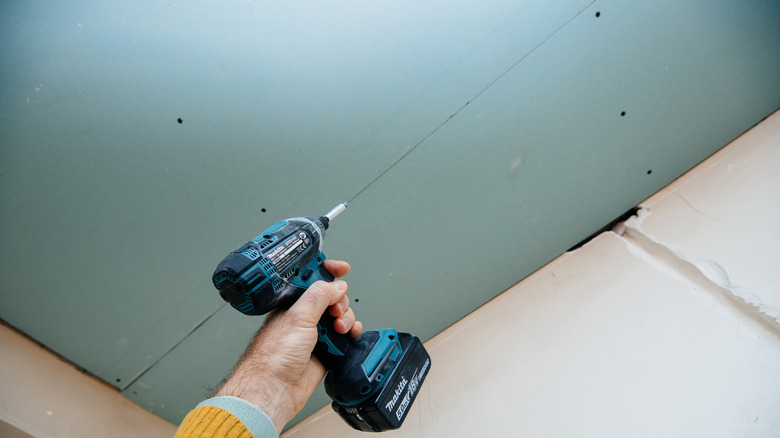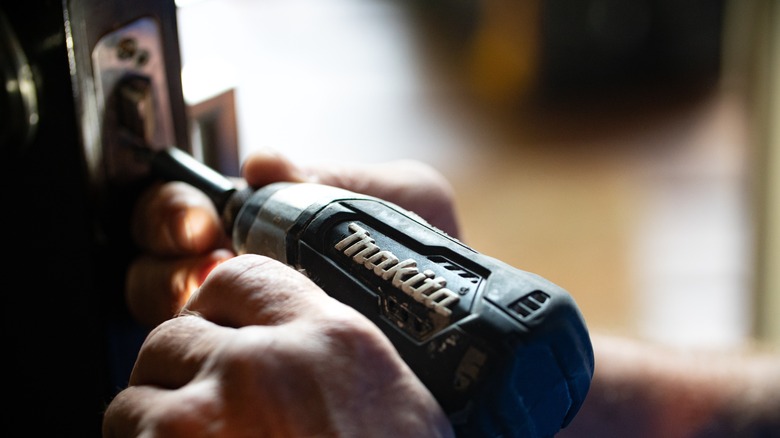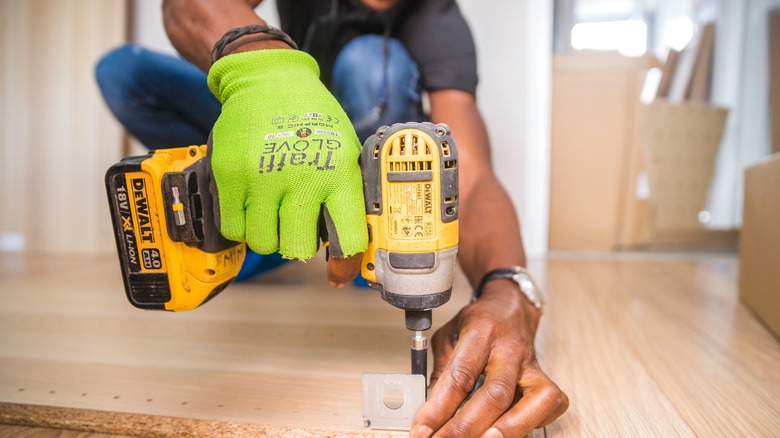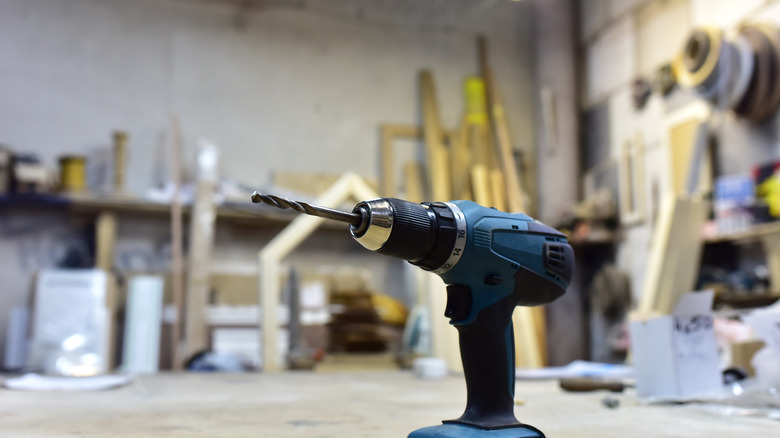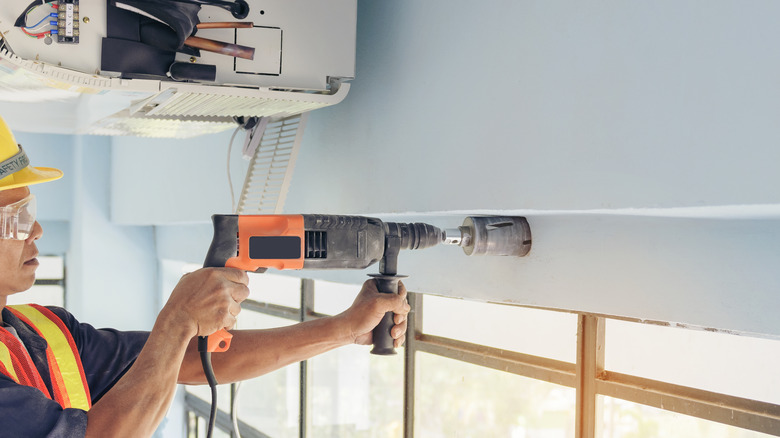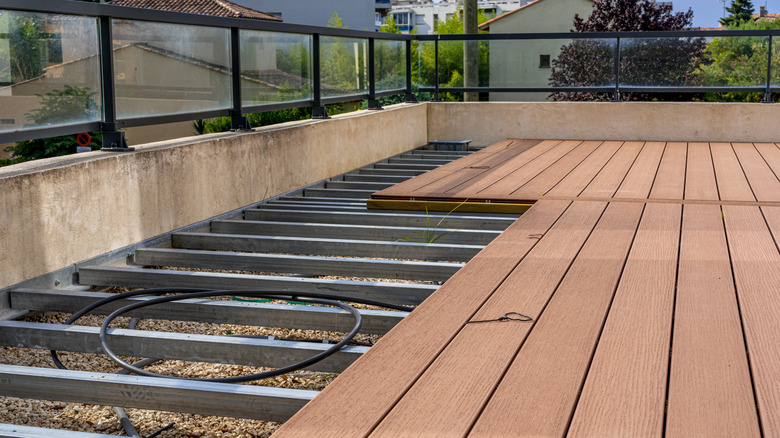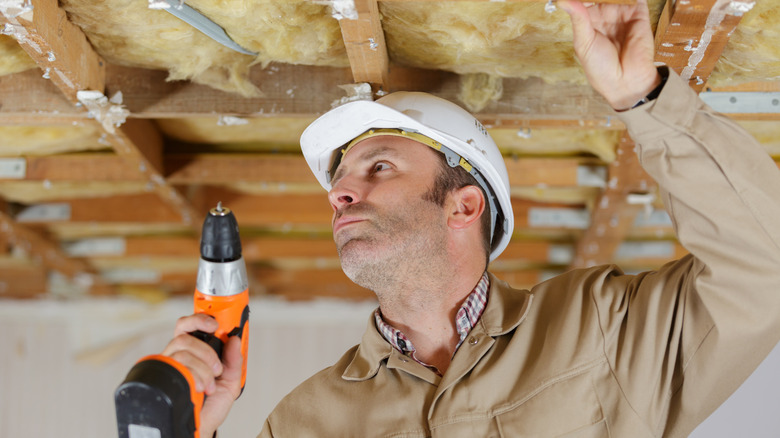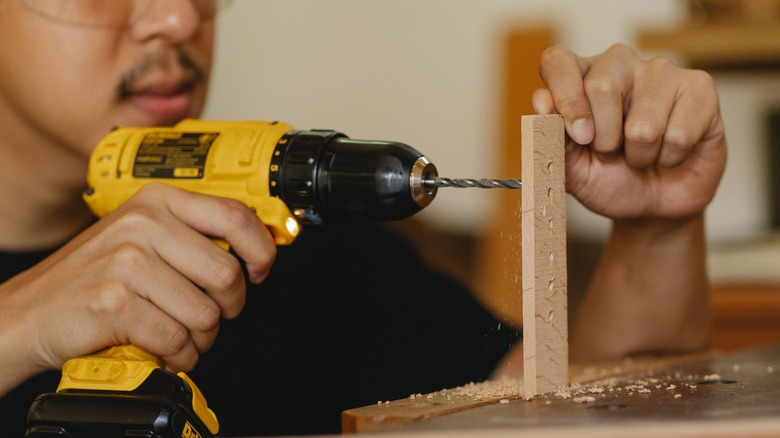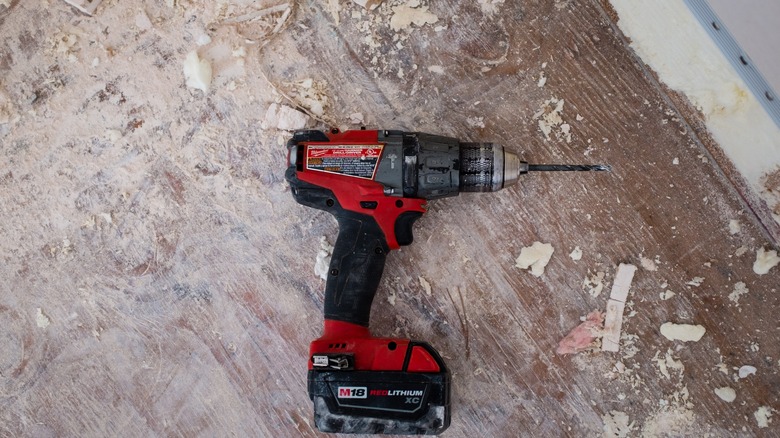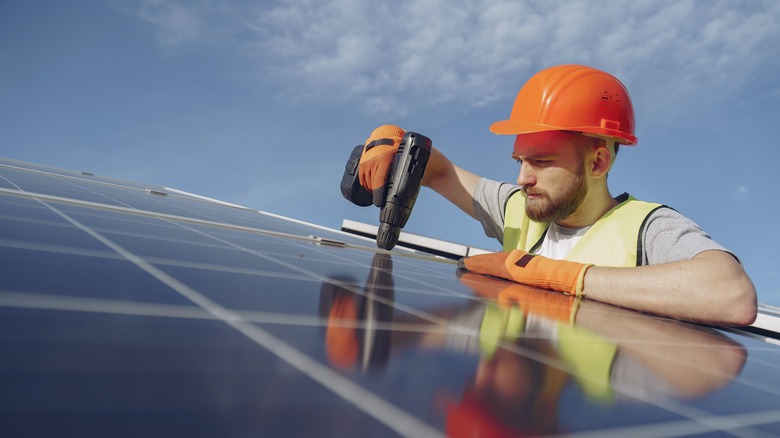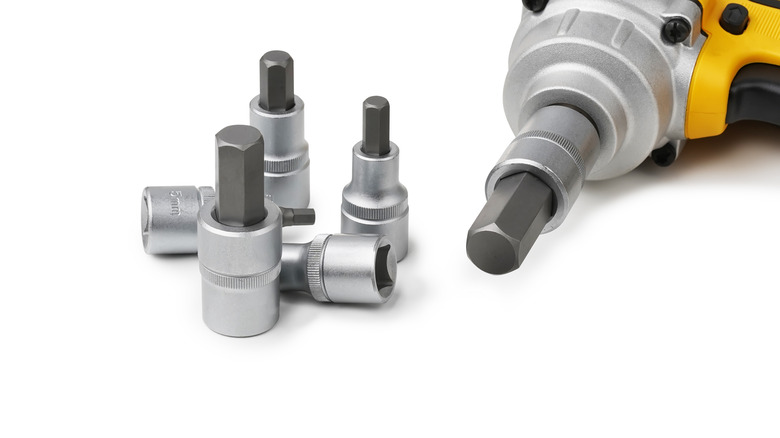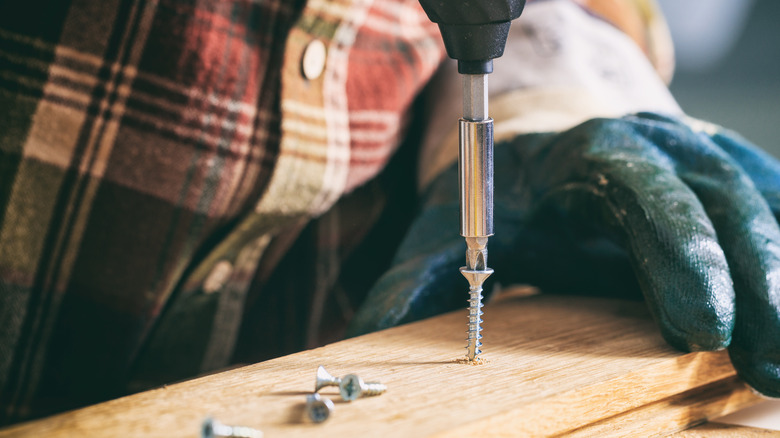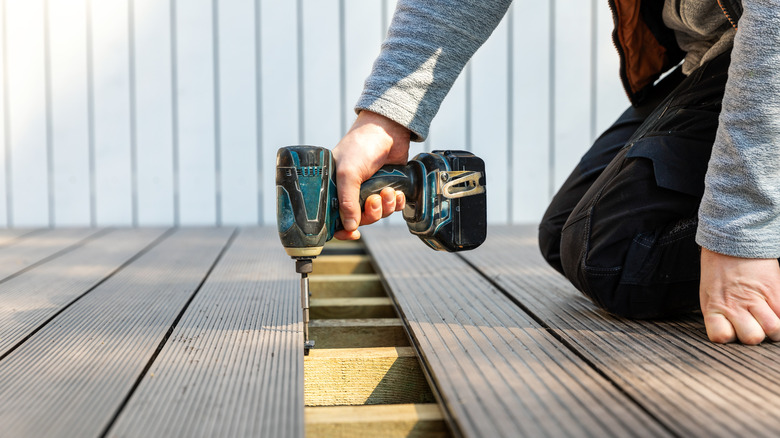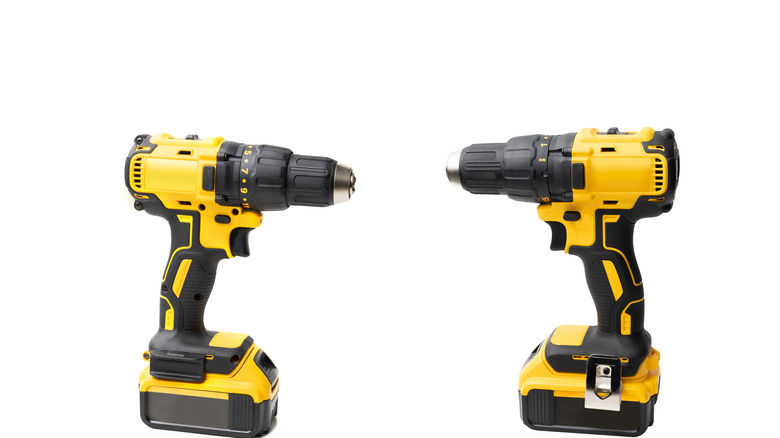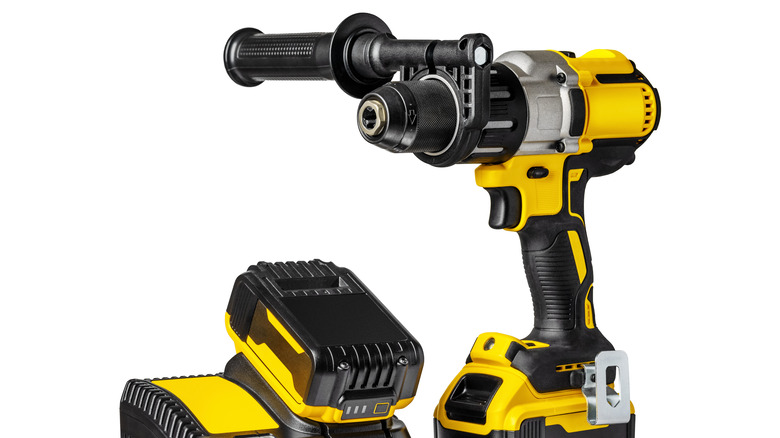What You Should Know Before You Buy An Impact Driver
Aside from wood and concrete, what tools and hardware are needed to build that gazebo, deck, or pergola before summer arrives? Will a drill work? The answer is a frustrating, inconclusive maybe. You'll be using many screws and maybe nails to build it, and a power drill is a go-to tool for making holes for those hardware pieces. Power drills are great for mixing concrete and paint, too. But you may want to consider an impact driver because it's useful for big projects and thick material.
Comparing power drills and impact drivers, The Tool Square explains that impact drivers are lighter than power drills, so for projects that will take hours and days of holding up a heavy power drill, using an impact driver may prevent injury. Also, you'll work faster with an impact driver because they have higher torque, as much as five times higher than a drill. So when you drive long screws into the thick lumber you'll use to build your deck, the impact driver will save you time and physical wear and tear.
They're versatile power tools as well. Impact drivers also come in handy for auto work, such as removing lug nuts.
What is an impact driver?
As the name suggests, an impact driver is a powerful tool with substantial torque and impact action. Professional carpenters, construction workers, electricians, and auto mechanics use them all of the time. They use impact drivers for driving screws and bolts into hard surfaces if the job calls for it. If you're new to this, nails, screws, nuts, washers, bolts, dowels, and rivets are all fasteners. But impact drivers supply short bursts of power to drive and remove bolts and screws only. Impact drivers resemble power drills, though most impact driver models are smaller and shorter. Impact drivers are often described by how they differ from drills functionally, but we'll get into that later.
As Bob Vila recommends, choose an impact driver if you have a big job ahead of you, like that gazebo or deck. In the long run, you'll save time and prevent physical pain (especially in the hand and wrist) because impact drivers go deep into thick timber and concrete and rigid materials like metal and plastic.
What parts comprise an impact driver?
It helps to know the parts of a drill because impact drivers share many of the same parts, with some exceptions. The guys at Mere Mortals illustrate the value of knowing the parts the tools have in common to understand better how they differ. A power drill has what's called a chuck, a round piece that clamps the drill bit in place with what looks like teeth. There's also a clutch, which limits the amount of torque used during drilling to avoid driving in too deep. You set the max torque with a dial.
Impact drivers don't have chucks. Instead, they only have a collet, which is like a chuck except it clamps the driver bits like a collar, rather than a jaw, with even force. Also, the impact driver accepts only 1/4-inch hex (hexagonal) shank driver bits for screws and bolts. Like drills, impact drivers have variable-speed triggers, but in addition to spinning, the impact driver delivers quick punches in the same direction. They lack clutches, which can be an advantage, explains Cordless Drill Zone, so they're shorter than drills and allow you to work in tighter spaces.
What's the difference between an impact driver and a drill?
Tools enthusiasts have lots to say about the pros and cons of impact drivers and power drills, though all agree each tool has its purpose. You can read up on the evolution of the drill to an impact wrench, then the impact driver, as Tool in Action outlines. A power drill is used to pre-drill holes into wood, drywall, and plastics and tighten or loosen stubborn bolts. The mechanism that differentiates drills from impact drivers is the rotating chuck. Drills have an adjustable clutch that gives you control over the torque. You can work more precisely because you can adjust the torque as you work and maintain that torque level. You avoid over-tightening fasteners and damaging the surface you're working with or stripping the hole. In other words, using a power drill is ideal for detailed work.
Impact drivers differ from power drills based on torque, among other things. It doesn't have a chuck with jaws like a drill but instead has a locking, quick-change collet that holds standard hex-shank drivers. The impact driver has a robust powertrain system, with the hammer and anvil as its main components. Its motor drives the spring-loaded hammer, rotating and striking the anvil simultaneous to the rotation of the hex chuck with its bit. The friction, power, and speed create the high torque output, making the impact driver the preferred tool for heavy work.
Types of impact drivers
There are three types of impact drivers: compact, corded, and cordless. All three have pros and cons, though cordless impact drivers are the most favored of the two, mainly because of convenience. Cordless impact drivers require compact batteries only, making them the lighter option. You can use them anywhere without worrying about finding a close power source. The Drive highlights that the portability of a cordless impact driver is a huge advantage for automotive use. When it comes to removing many bolts, lug nuts, trim screws, and other automotive components that you find in most vehicles, efficiency is always appreciated.
Corded impact drivers require a cord and, therefore, limit your range. One advantage of the corded option is that you don't have to worry about recharging the battery. You can use it all day without fussing to break up your day to recharge. Corded drivers offer more consistent power and torque, even today, with parts and electrical systems advancements. This is one of the reasons auto repair professionals use corded impact drivers. Their super-strength torque is best for removing rusted nuts and bolts. A large-sized impact driver can work as a stand-in for an impact driver.
What is an impact driver best used for?
Impact drivers are useful power tools for multiple reasons, making them a must-have for any home, explains The Spruce. They have greater rotational force, around 50 times per second, plus powerful torque for driving screws and bolts into wood, concrete, and even metal. Because they're lighter-weight than most cordless drills, impact drivers are great for big projects like building a deck or fence. Hold a heavy power drill for hours every day for several weeks, and you'll wish you'd had an impact driver.
A compact impact driver might serve you well when you're working on your car engine, as they're easier to maneuver in tight spaces. The intelligent design of a compact, light-weight impact driver allows you to use it with one hand as it prevents recoil and your losing grip of the tool. They offer the power and torque needed to remove 12 mm bolts and nuts, even lug nuts.
What are the pros and cons of impact drivers?
An impact driver is an outstanding tool for its versatility and efficiency. But it's not the perfect tool for everything. Pros and cons are mainly categorized based on the intended use. We've looked at what impact tools are used for already, so here are some general pros and cons to mull over.
Koopman underlines that the superior quality impact drives have over drills are power and torque for hard, thick, inflexible surfaces. These surfaces require longer screws, and an impact driver requires little effort from you to drill them. The internal mechanism senses how much force or power is needed, then delivers quick downward rotary bursts to produce more torque. On the downside, impact drivers have no torque control setting. You can only change the amount of torque by using the speed control trigger or by selecting a model with several gears.
Why you might not need an impact driver
Not to be pedantic, but you may not need an impact driver when what you really need is a drill. Handyman's World advises that using the wrong tool for the situation has consequences. Not only will your work at the moment be compromised, but the whole project you're working on, whether that's drilling into concrete foundations or working on your car.
Power drills are better for precision work because you have better control. Also, drills are primarily used for drilling small holes or screwing in small fasteners. Impact drivers fix large fasteners into difficult surfaces with lots of power. That's why you don't want to use an impact driver if you're working with softwoods (pine, fir, or spruce), drywall, or plastics. Drills have slip clutches so you can control the torque. Standard power drills are primarily used for drilling holes and screwing in small fasteners.
Impact drivers are built to screw large fasteners into tough material or disassemble them efficiently. Thanks to the torque, they're also beneficial when long screws are needed.
How do you maintain an impact driver?
Grainger's advice on power tool maintenance applies to impact drivers as well. Like all power tools or motorized implements, they need to be appropriately stored and maintained to function optimally. Just think about your car. If the engine overheats, pull over and read the owner's manual. Clean your impact driver after every time you use it. It's simple; use a cloth to wipe off debris. Again, as with all motorized tools with moving parts, lubrication is essential. Before you apply lubrication, read the owner's manual. You may need a specific type for your impact driver. Calibration and bit sharpening are two more things you need to attend to. For these, check your owner's manual for the maintenance schedule.
Storing your impact driver properly is equally important as following proper maintenance protocol to keep your driver running optimally for as long as possible. Promaker offers thorough recommendations for power tool storage. Among their many helpful suggestions, a few stand out as basic but easily overlooked, such as removing your impact driver from its original box. Instead, hang it on a tool rack or pegboard, or place it in a toolbox. Impact drivers should have ample ventilation while in storage and protection from dust and moisture.
Average cost of an impact driver
You guessed it! Impact drivers vary considerably in price. The fundamental features that drive the cost of impact drivers are torque, voltage, BPM (blows per minute), and, for cordless models, battery quality. According to Cordless Drill Zone, an impact driver that rates high on these basic qualities will be pricier than others. Add on desirable features like built-in assist mode for controlling speed and torque, trigger activation, LED light for working in dark spaces, lithium-ion battery and recharger, and accessories such as storage bags and cases, the more expensive the product.
Impact drivers that rank highest for their superior features cost over $300. But not everyone needs all that technology. Average-quality, lower-priced options run around $150. Suppose you want a product that falls somewhere in between, one that performs well for basic applications but isn't too technical. In that case, you can find an impact driver for between $200 – $300.
The most common mistakes
People who misuse impact drivers likely misuse other power tools because they lack knowledge and experience. Do you remember when you used a screwdriver to build a birdhouse, or similar project, for shop class? If so, perhaps you can understand how easy it is to over-tighten the screw to compensate for poor alignment. The worse it gets, the tighter you go. Of course, this tactic can backfire. You may damage threads, which only worsens the already-poor fit between screw and bolt. Using the wrong socket is also a common mistake. As In Trona Ut reminds DIYers, you risk damaging the tool and work if you buy the wrong size or type of impact driver for your project.
A frequent mistake many of us would not want to admit, is not knowing how to use the impact driver in the first place. The folks at Emission Time outline common errors people make with impact wrenches, which share attributes with impact drivers. Their general recommendations carry over. To avoid mistakes, clear up your working station, use care when operating the impact driver, and unplug the driver or remove the battery and set it in its charging station.
How do you repair an impact driver?
Like any power tool, if your impact driver won't start, makes irregular noises, or emits an odd odor, explains Dig This Design, it needs repair. Diagnosing the problem may require advanced knowledge, but there are a few things you may be able to problem-solve even if you're an amateur. If your corded impact driver won't start, inspect the power cord for kinks, tears, or other signs of damage. For cordless impact drivers, an inefficient battery may be the culprit. Make sure it's fully-charged. If the battery won't hold a charge, you may need to replace it. Changes in sound and smell are signs that your impact driver may indicate damage to the powertrain system or an overheating motor.
To make a repair, advises Geariz, you need to know the basic steps of power tools in general. You also need to have the following tools to make the repair: screwdriver magnetizer, torque wrench shaft, socket, and grease. Then you disassemble your driver, make the repair, and reassemble the parts correctly. Check out EZ Tool Hub to get an in-depth look beyond the names of impact tool parts (bit holder, hammer, motor, and housing).
When in doubt, it's always best to contact the manufacturer or find a tool repair store you trust.
Can I use my impact driver as a drill?
Yes, you can use an impact driver as a drill, but only in some instances. The primary function of the impact driver is to drive and disassemble screws and bolts. The main attraction is its superior torque. So you don't want to use an impact driver when you need to drill precise holes and risk damaging the surfaces of the intricate shelves you're building. Also, impact drivers are made for 1/4th hex shank driver bits only. Drill bits aren't designed to withstand the torque of an impact driver, emphasizes Rockwell. But if what you're working on requires only rough holes for wires, for example, an impact driver works fine.
Again, impact drivers don't create small and precise holes the way drills do. Power drills are the better choice for precision work in general, largely because they have slip clutches that give you control of the torque. Also, their primary uses are for drilling small holes or screwing in small fasteners.
As Essential Home and Garden explains, you need a power drill if you're trying to thread wire through a wall. Impact drivers apply ample torque to drive large fasteners, so don't use an impact driver if you're working with softwoods (pine, fir, or spruce), drywall, or plastics.
What size impact driver do I need?
There are three sizes to choose from: ¼, 3/8, and ½-inch impact drivers. They are low, medium, and high in power from small to large sizes. The smallest is most accurate than the largest size, and both the ¼ and 3/8-inch impact drivers work well for tight areas. But which do you need for your project? It's critical that you use the appropriate size for the job, according to 99 Power Tools.
Suppose you're working in more expansive areas like the exterior of your house. In that case, the ½-inch impact driver is best because it's most powerful. Outdoors, you don't have to worry about the impact driver's size, so take advantage of the high torque.
On the flip side, you often have to work on tight areas where accuracy matters most; then, nothing can beat the efficiency of a 3/8-inch impact driver. In addition, it's comparatively light in weight which allows users to work with the maximum comfort possible.
Although a 1/4-inch impact driver works just fine in tight areas, the level of accuracy may drop down from time to time.
What features should you look for?
A brushless motor is considered superior to brushed motors because they last longer and don't generate as much heat. Just about any motorized appliance, from ceiling fans to food vacuum packers, have brushless motor options. Other desirable features include voltage, variable RPM ranges, ease of use, and more, as Build Review clarifies.
Look for impact drivers with variable RPM ranges. Impact drivers are known and used for their brute force. But not all jobs require constant and intense force. To drive fasteners with a bit of finesse, look for models with three or four speed settings ranging from 0 to 3000 RPM. Say you're trying to remove a corroded fastener or a similarly difficult task. In that case, you'll need to be able to reach max torque quickly, then slow it down.
Another thing to look for in an impact driver is a toggle feature so you shift directions with your thumb and index finger. For safety, make sure your impact driver has a trigger lock switch to prevent battery drainage if you accidentally press the trigger.
